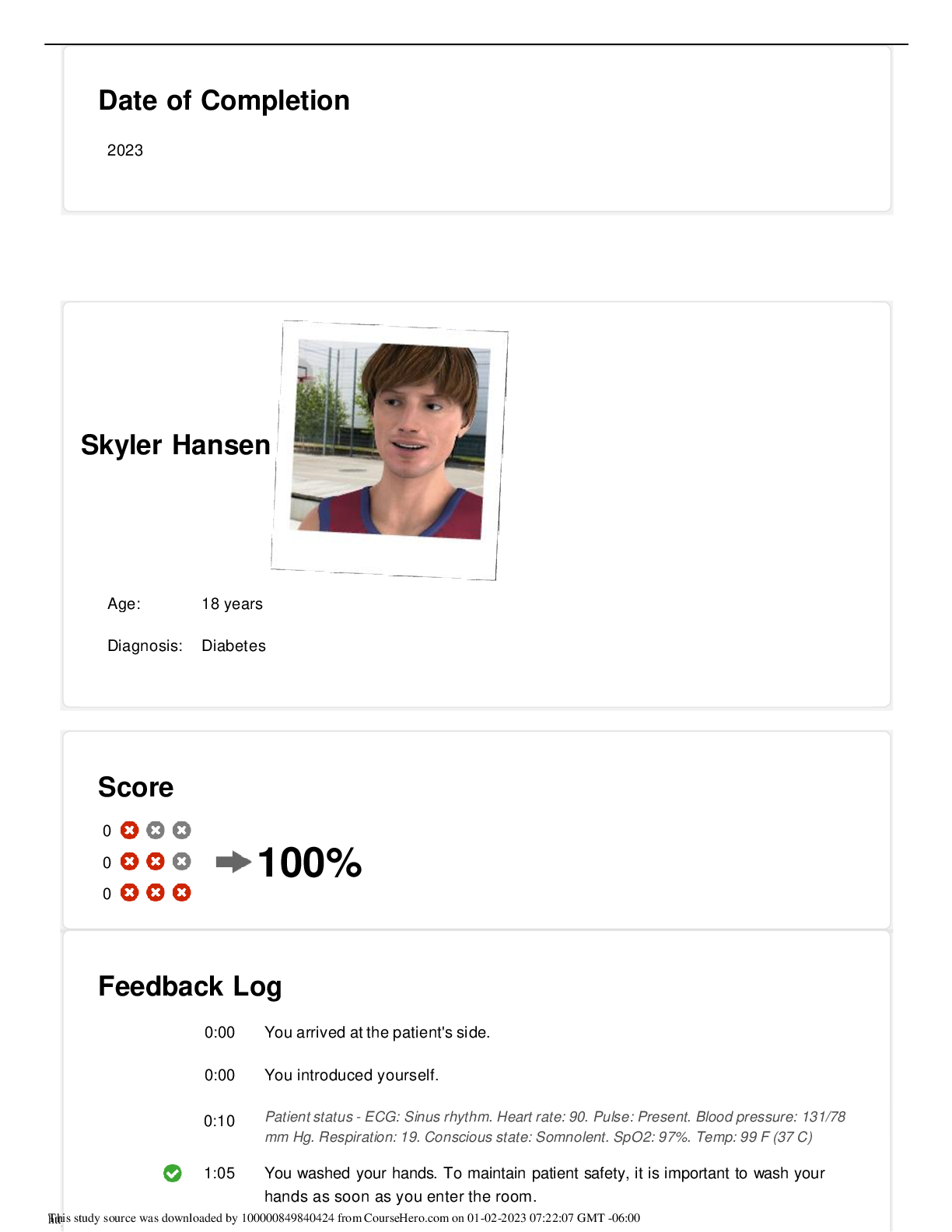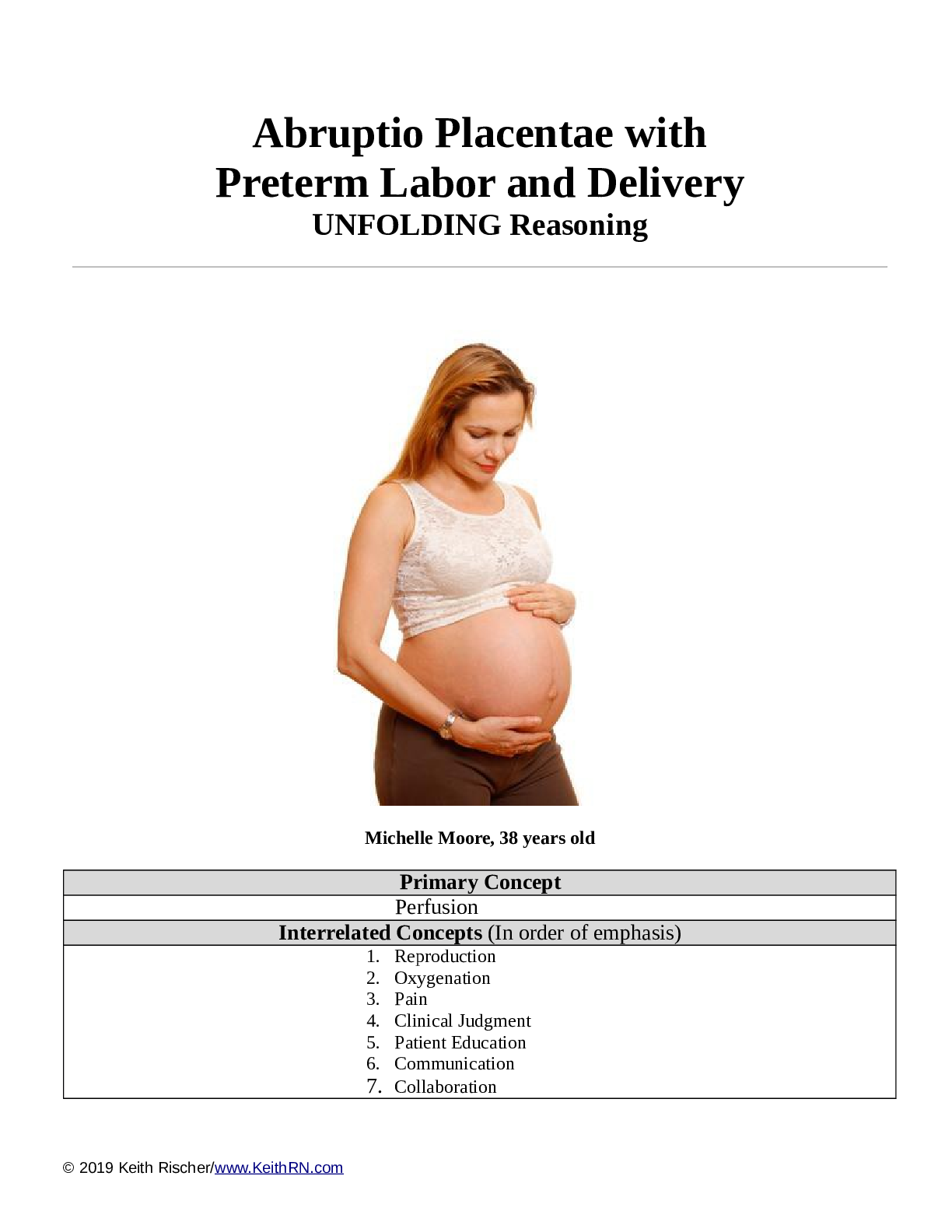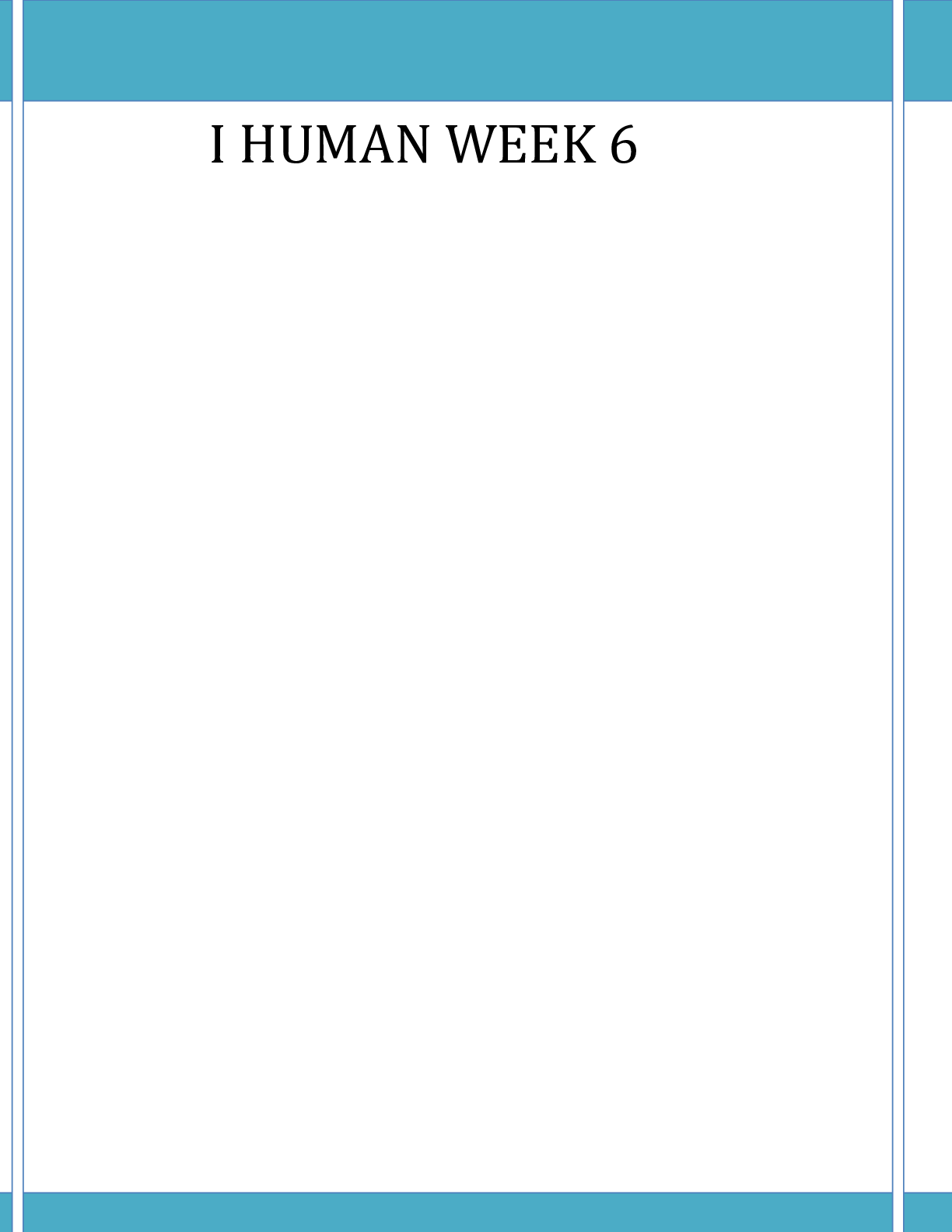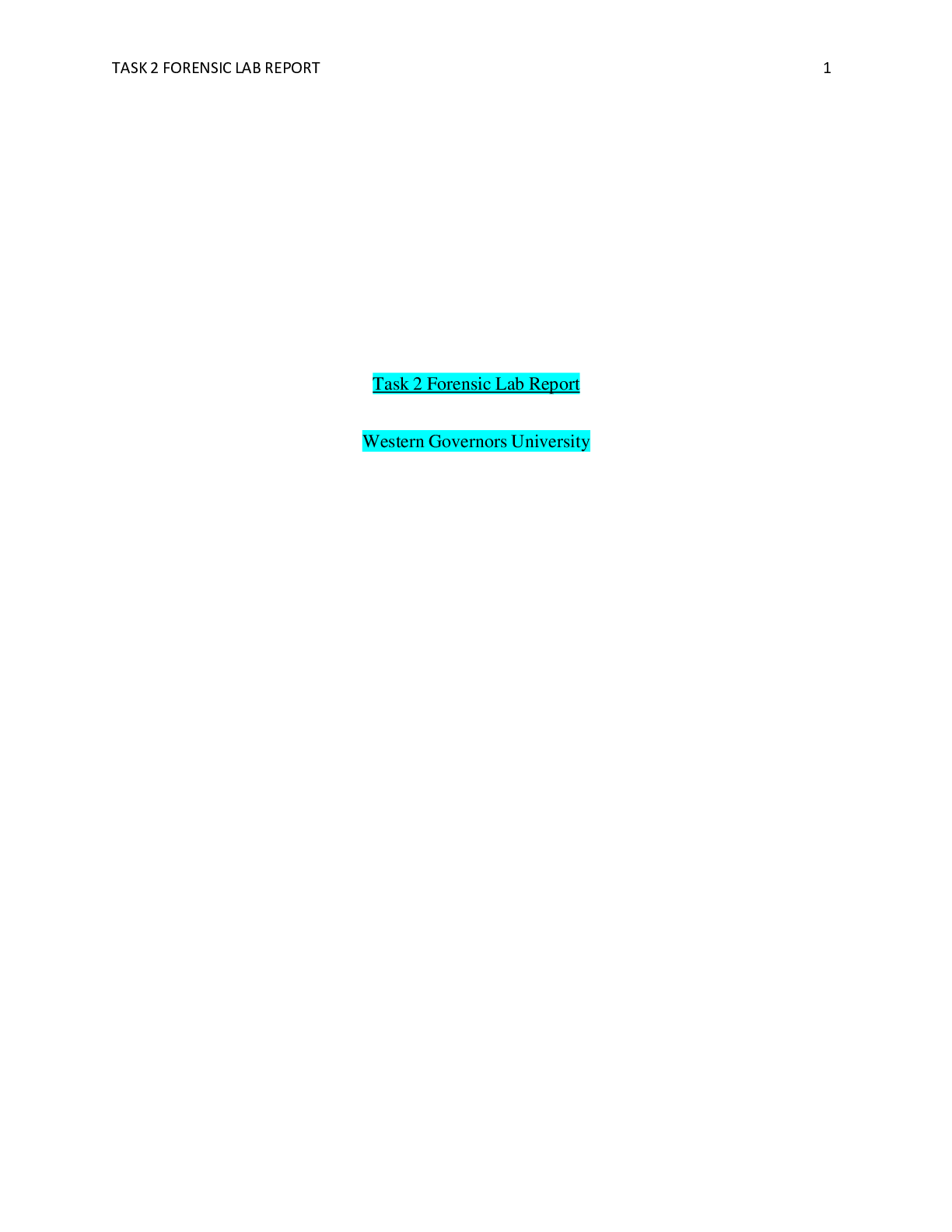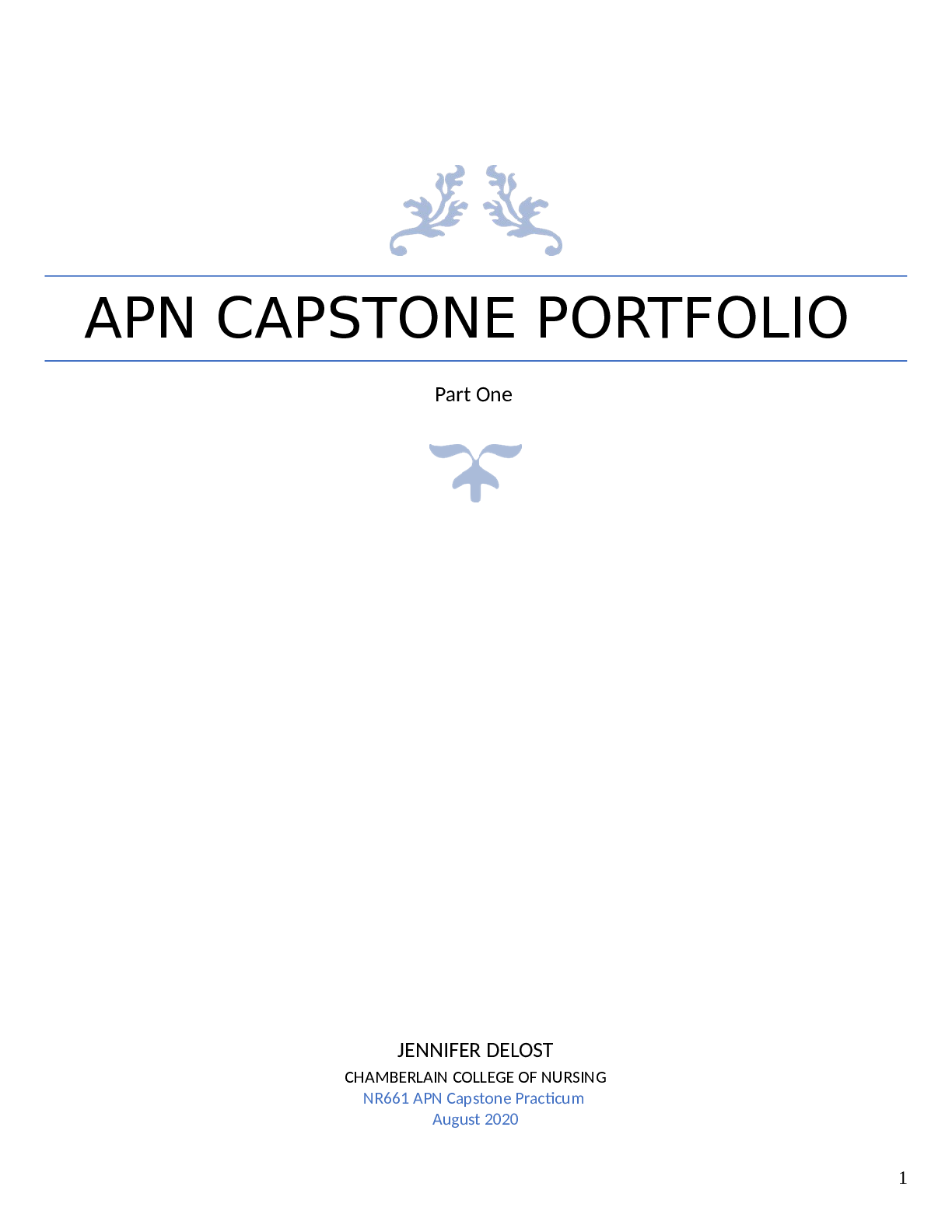Summary NSG 405 EXAM 1 Completed Study Guide > latest (Spring 2020/2021)
Document Content and Description Below
NSG 405 EXAM 1 Completed Study Guide EMERGENCY NURSING – LECTURE 1 Obstacles/appropriate action to obtain consent for treatment • Consent to examine and treat the patient is part of the ED record.... • The patient needs to give consent for invasive procedures unless he or she is unconscious or in a critical condition and unable to make decisions. o If the patient is unconscious and brought to the ED without family or friends, the fact must be documented. • After treatment, a notation is made on the record about the patient’s condition, response to the treatment, and condition at discharge or transfer and about instructions given to the patient and family for follow-up care. • Consent o Consent to examine and treat needs to be part of the ED record for every patient o Exception if the patient is unable to consent and there is not proxy that can consent on the patient’s behalf (but then that condition needs to be well documented. Nursing responsibilities for sexual assault victim • SANE Nurse Triage systems (ESI & CTAS) – what are factors considered in each system, be able to recognize examples of what might fall into different triage levels. o Five levels include time parameters that guide how frequently patients must be reassessed by either a nurse or provider. o Patients assigned to the resuscitation category must receive continuous nursing surveillance those in the emergent category must be reassessed at least every 15 minutes patients in the urgent category must be reassessed at least every 30 minutes patients in the less urgent category must be reassessed at least every 60 minutes those in the nonurgent category must be reassessed at least every 120 minutes Components of the primary patient survey/initial assessment in the ED • Primary Survey o Assessment focuses on stabilizing life threatening conditions • ABCDE method • A—alert o Is the patient alert and responsive? Not necessarily oriented to time and place or neurologically normal • V—verbal o Does the patient respond to verbal stimuli? Not fully awake. Only responds to verbal stimuli • P—pain o Does the patient respond only to painful stimuli? Difficult to rouse and only responds to painful stimuli • U—unresponsive o Is the patient unresponsive to all stimuli, including pain? Completely unconscious with no response. • After these priorities have been addressed, the ED team proceeds with the secondary survey. Airway obstruction – assessment/management o Increased respiratory difficulty o Cyanosis • Management of Airway Obstruction o Oxygen supplementation o Inspection of the oropharynx May use X-Ray or laryngoscope o Establish airway by: Hemorrhage – s/s of external vs internal hemorrhage, complications (e.g., lactated Ringer’s, normal saline), colloids, and blood component therapy. o Blood typing for anticipated need for transfusion Blood samples are obtained for analysis, typing, and cross-matching Replacement fluids are administered as prescribed, depending on clinical estimates of the type and volume of fluid lost o Transfusion of PRBC’s, platelets, or clotting factors as indicated Packed red blood cells are infused when there is massive blood loss, which may also necessitate transfusion of other blood components, including platelets and clotting factors o External hemorrhage Apply direct, firm pressure • firm pressure is applied over the bleeding area or the involved artery at a site that is proximal to the wound • Most bleeding can be stopped or at least controlled by application of direct pressure • unchecked arterial bleeding results in death A firm pressure dressing is applied, and the injured part is elevated to stop venous and capillary bleeding, if possible A tourniquet is applied to an extremity only as a last resort when the external hemorrhage cannot be controlled in any other way and immediate surgery is not feasible • The tourniquet is applied just proximal to the wound and tied tightly enough to control arterial blood flow o Internal hemorrhage Multiple trauma – prioritization Food Poisoning Intoxication ACUTE GI – LECTURE 2 Localization of Pain • Referred pain • Peritoneal Signs NG Tube • NG Tube Placement o NEX Measurement NEX = Nose, earlobe, Xiphoid process • The first mark on the tube is made at the distance from the nose to the earlobe. • It indicates the distance to the nasal pharynx, a location that places the tip at the back of the throat but above where the gag reflex is stimulated. • A second mark is made at the point where the tube reaches the xiphoid process, indicating the depth required to reach the stomach o Chest X-ray – gold standard for placement confirmation o Mark placement of tube at nares after placement confirmation and record on assessment flow sheets. o Mark placement of tube at nares after placement confirmation and record on assessment flow sheets. o Elevate HOB 30-45 degrees during and for at least one hour after feeds to prevent aspiration o Monitor residual volumes o Maintain hydration by supplying additional free water as ordered, assess for dehydration o Promote coping and support o Patient education to promote as much independence as possible o Azotemia because of altered fluid balance, can have dehydration or increased BUN/Creat, sign of kidney damage, will likely see decreased urine output, more concentrated urine Diarrhea, C. Diff Precautions o Laxatives should be used sparingly, promote regularity, then back off, don’t want the bowel to become dependent on stimulant laxative in order to function Peptic Ulcer Disease • 14.5 million Americans o 1.4 outpatient visits and 489K hospitalizations annually • Peptic ulcer may be gastric, duodenal, esophageal • An excavation (hollowed out area) that forms in the gastric mucosa, erosion may extend through to the muscle layers • Most are associated with H. pylori infection o Can be acquired through the ingestion of food and water or person to person with close contact • Other Risk Factors: use of NSAIDs, smoking and alcohol may be related, familial tendencies, people with type O blood • Although H. pylori infection is common in the United States, most infected people do not develop ulcers. It is not known why H. pylori infection does not cause ulcers in all people, but most likely the predisposition to ulcer formation depends on certain factors, such as the type of H. pylori • Symptoms: Inflammatory Bowel Disease – Nursing Care/Education pharmacologic and non-pharmacologic o The nurse administers anticholinergic medications 30 minutes before a meal as prescribed to decrease intestinal motility and administers analgesic agents as prescribed for pain. Position changes, local application of heat (as prescribed), diversional activities, and prevention of fatigue also are helpful for reducing pain. Liver Failure – Management, medications, Assessment for acute complications • Acute Hepatic Disorders o Clinical Manifestations Jaundice Portal Hypertension • Ascites • Esophageal Varices Vitamin Deficiency Hepatic Encephalopathy/Coma Bleeding o Jaundice Common symptom of a liver disorder Bilirubin is released in the blood when RBCs break down (normal process) In the liver this is usually bound with bile, then taken out of the body to be eliminated If bilirubin is not moved through the liver and bile ducts appropriately, it builds up in the blood and gets deposited in tissues Yellowing of the skin, mucous membranes, whites of the eyes May have light colored stool and dark colored urine Itching of the skin • Portal Hypertension • Hepatic Encephalopathy o Assessment: EEG Assess changes in LOC (Glasgow scale) Asterixis – wrists and fingers lose tone, “flap” Apraxia – motor deficit, difficulty performing common tasks Fetor hepaticus – alcohols (thiols) pass into the lungs, resulting in acetone/sweet smelling breath o Nursing Management: Assess for seizure activity, seizure precautions Monitor F/E balance Monitor ammonia levels – can potentially be life threatening levels o 4 Stages of Hepatic Encephalopathy Stage 1 • Periods lethargy/euphoria • Reversal day: night patterns • Asterixis, normal EEG Stage 2 • ↑drowsiness/disorientation • Mood swings, agitation • Fetor hepaticus, Asterixis, abnormal EEG (generalized slowing) Stage 3 • Marked confusion stupor • ↑DTRs, asterixis, rigid extremities • EEG markedly abnormal Stage 4 • Coma • Flaccid extremities • Absence of DTRs, no asterixis o Management: Eliminate precipitating cause Lower ammonia levels • Lactulose to reduce serum ammonia levels • Reduction of ammonia from GI tract by gastric suction, enemas, oral antibiotics • Protein restriction Discontinue sedatives, analgesics, and tranquilizers Monitor or treat complications and infections • Other Manifestations of Liver Disease o Bleeding Hypoalbuminemia, Hypersplenism Ecchymosis, epistaxis, GI bleeds, thrombocytopenia o Vitamin Deficiency ↓ADEK- 2o decreased absorption r/t ↓bile salts Poor intake • ↓Vit A. • ↓Thiamine • ↓Riboflavin • ↓Pyridoxine • ↓Vit. C. • ↓Vit. K. • ↓Folic Acid o Metabolic Abnormalities ↓glycogen reserves & ↓gluconeogenesis Endocrine abnormalities: • Gynecomastia • amenorrhea/irregularities • testicular atrophy Pruritus & Skin Changes • Retention of bile salts • Spider angiomas (above the waistline) • Palmar erythema Bowel Obstruction – s/s, complications, management o Coping and self-care promotion SHOCK & MODS – LECTURE 3 Stages of Shock – Clinical Signs in each stage, complications Stages of Shock o Compensatory • • Clinical Manifestations of Compensatory Stage: • B/P May be normal • HR > 100 BPM, weak • Respiratory Status >22 breaths/min • Skin Cool & clammy • Urinary Output Decreased • Mentation Confusion, agitation, anxiety • Acid-Base Balance PaCO2 <32, Respiratory alkalosis • Increased respiratory rate to try to increase oxygenation. o But in the process blows off too much CO2, decreasing carbonic acid, leading to an alkalosis state Nursing Management of Compensatory Stage • Early recognition of shock is key to a good prognosis • Primary goal of treatment is aimed at identification & reversal of cause • Initiation of fluids to increased BP and promote perfusion • Close monitoring of vital signs, watch for narrowing of pulse pressure o Report systolic pressure <90mmHg or drop in systolic pressure >40 mmHg from baseline • Frequent LOC checks • Monitor urine output • Monitor labs o ABGs o lactic acid o electrolytes • SBP-DBP= PP o Narrowing PP earlier indicator of shock Increasing DBP with release of catecholamines+ vasoconstriction o Progressive • Disseminated Vascular Coagulation (DIC) Skin appearance of Progressive Shock • • Nursing Management of Progressive Stage Types of Shock – Know variations in symptoms and/or management from one type to another • inadequate specificity and sensitivity of the systemic inflammatory response syndrome (SIRS) criteria Shock Management (in general) ACUTE RENAL & MALE GU – LECTURE 4 NUMBERS TO MEMORIZE: UTI – Symptoms, Teaching Prostate Cancer – Screening, post prostatectomy care Testicular Cancer – patient teaching/screening Relate renal failure to other systems Kidney Stones – interventions, management, patient education • If voiding dysfunction goes undetected and untreated, the upper urinary system may become compromised. • Incomplete bladder emptying due to bladder outlet obstruction, causing high-pressure detrusor contractions, can result in hydronephrosis from the high detrusor pressure that radiates up the ureters to the renal pelvis. BPH – Benign Prostatic Hyperplasia • ED – Medication Teaching Nephrotic/Nephritic Syndromes – Symptoms/manifestations o o [Show More]
Last updated: 2 years ago
Preview 1 out of 36 pages

Buy this document to get the full access instantly
Instant Download Access after purchase
Buy NowInstant download
We Accept:

Reviews( 0 )
$15.00
Can't find what you want? Try our AI powered Search
Document information
Connected school, study & course
About the document
Uploaded On
Dec 17, 2020
Number of pages
36
Written in
Additional information
This document has been written for:
Uploaded
Dec 17, 2020
Downloads
0
Views
108



